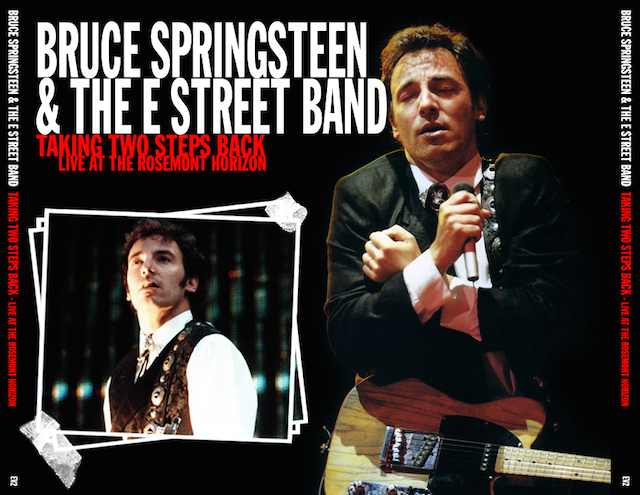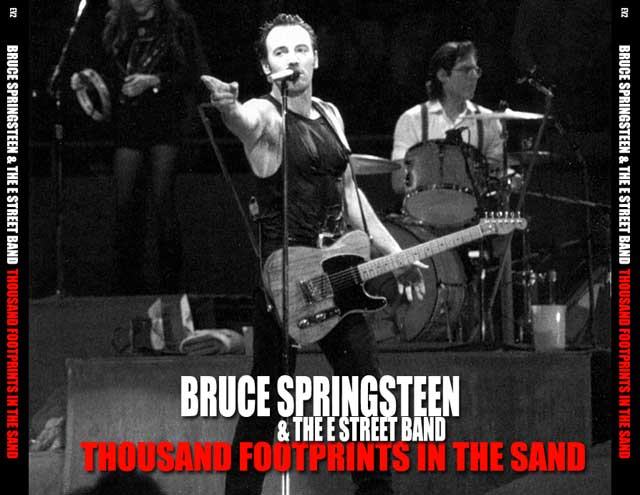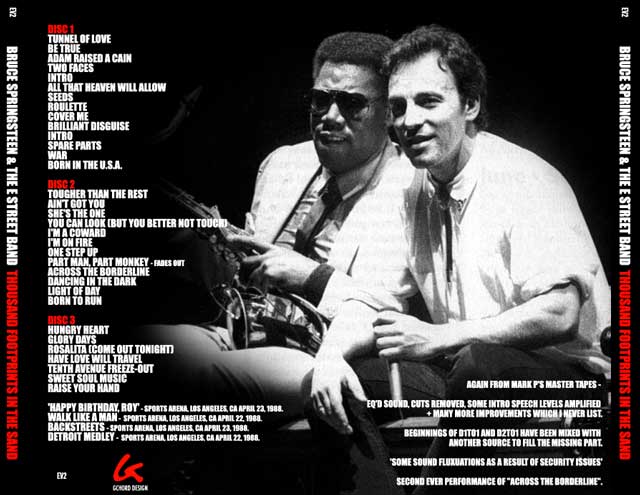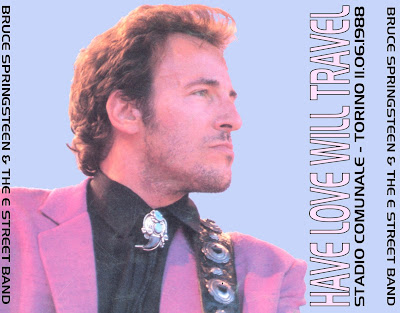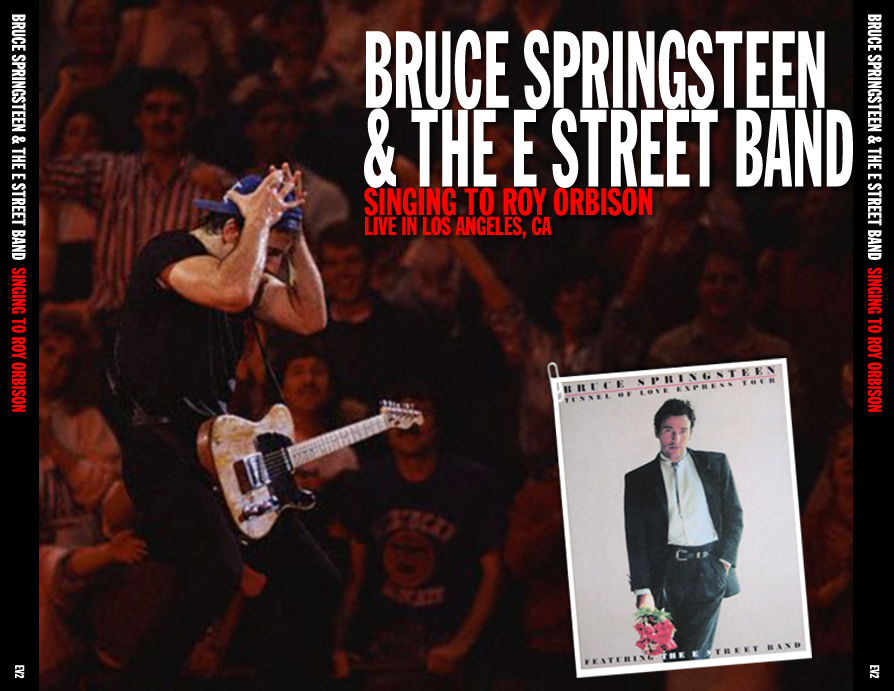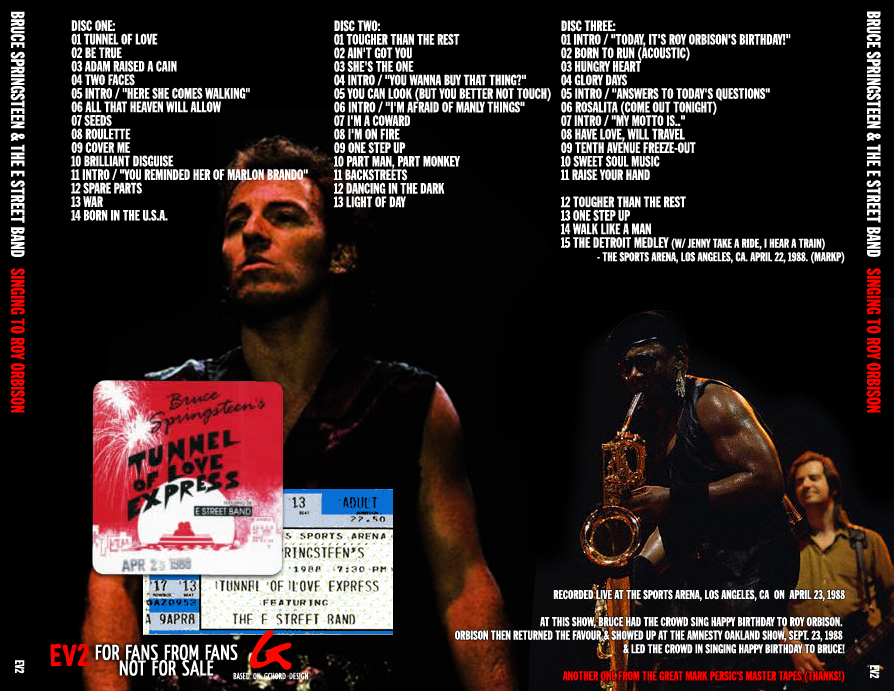Articolo tratto da un numero di Rolling Stones del 1988, inutile dire che l’ argomento è Springsteen ed il suo nuovo disco Tunnel of love.
Bruce Springsteen’s
TUNNEL VISION
After the mammoth success of ‘Born in the U.S.A.’,
the rocker took a hard look at his career and decided
to bring his music back to human proportions
By Steve Pond
THE AUDIENCE CONSISTS OF; HIS SOUND CREW, HIS sax player’s wife and son
and a couple dozen ushers and security guards. But that doesn’t stop Bruce
Springsteen, who’s turning in an extraordinary performance at the Omni, in Atlanta.
He’s in the middle of a late-afternoon sound check – not one of the marathon sound
checks for which Springsteen used to be known but an hour-long chance to refresh
his music by playing oldies or current favorites or whatever pops into his head.
Springsteen stands in the middle of the huge white stage in jeans and a
longsleeved white shirt, laughing as he tries to piece together half-remembered Iyrics,
joking when a band member tosses out the riff from a familiar oldie and muttering,
“Okay, what next?” when he finishes a tune. It’s a country and folk set: the Everly
Brothers, Hank Williams and some lesser-known choices. Some songs fizzle out after
a verse or two; every so often, though, Springsteen and the band instinctively craft a
full-bodied arrangement, grab a song and claim it as their own.
That happens during “Across the Borderline,” a six-year-old song by Ry Cooder,
John Hiatt and Jim Dickinson from the movie The Border. A plaintive lament about
Mexicans in search of an American paradise, the song is one of Bruce’s current
passions: one person in Springsteen’s entourage says he’s driven everyone crazy
playing it in the van.
So when Springsteen sings its opening lines, the members of the band quickly
latch on to the slow groove; they’ve heard this one before. Guitarist Nils Lofgren picks
up a slide and adds an aching counterpoint to Springsteen’s vocals. By the first
chorus, this has become a performance to break hearts: “When you reach the broken
promised land Every dream slips through your hand And you’ll know that it’s too late
to change your mind ‘Cause you’ve paid the price to come so far/Just to wind up
where you are/And you’re still just across the borderline.”
Like the best of Springsteen’s own music, this is a song with a deep sense of
consequences. Not only do its lines about shattered dreams and broken promises
recall his songs, but the song seems to speak directly to the experience of a man who
dreamed of becoming a rock star, then became the biggest, who found himself feeling
isolated and empty and fought that by reassessing his work, then by turning to his
marriage; who at age thirty-eight has set aside his fervent belief that rock and roll can
save you in favor of the more sober idea that love might save you – if you work at it
hard and long enough.
“I guess I used to think that rock could save you,” he says later. “I don’t believe
it can anymore. It can do a lot. It’s certainly done a lot for me – gave me focus and
direction and energy and purpose. I suppose, when I was a kid, it was your best
friend: your new 45, man that was your best buddy.
“But as you get older, you realize that it is not enough. Music alone – you can
take some shelter there, and you can find some comfort and happiness you can
dance, you can slow-dance with your girl, but you can’t hide in it. And it is so
seductive that you want to hide in it. And then if you get in the position of somebody
like me, where you can if you want to, you really can.”
He stops himself. “Well, you think you can, anyway. In the end you really can’t,
because no matter who you are, whether it’s me or Elvis or Michael Jackson, in the
end you really can’t. You can use all your powers to isolate yourself, to surround
yourself with luxury, to intoxicate yourself in any particular fashion that you so
desire. But it just starts eating you away inside, because there is something you get
from engagement with people, from a connection with a person, that you just cannot
get anyplace else. I suppose I had a moment where I kinda crashed into that idea,
before I was married….
“It’s just confusing. Even the type of connection you can make in your show,
which is enormous, you can’t live there. You have three hours onstage, and then you
got the other twenty-one. You may know exactly what you’re doing in those three
hours, but you better figure out what you’re gonna do in them other twenty-one,
because you can’t book yourself around the clock.”
THE FIRST THING I DID, SPRINGSTEEN SAYS, WAS make everyone stand in a
different place.” It was the first day of rehearsals for the Tunnel of Love Express, and
he knew it was time for a show that would be drastically different from the stadiumrock
blowouts that had followed his album Bonn in the U.S A. – especially since those
shows had themselves been similar to the acclaimed concerts he’d been doing ever
since he started playing large arenas in 1978.
So he moved the members of the E Street Band out of the places most of them
had occupied onstage for the past thirteen years: drummer Max Weinberg moved to
the side; pianist Roy Bittan and keyboardist Dan Federici traded places; so did
guitarist Nils Lofgren and bassist Garry Tallent; sax man Clarence Clemons shifted
from Bruce’s right to his left; and singer Pam Scialfa picked up a guitar, moved into
Clarence’s old position and became Springsteen’s new onstage foil. A horn section
recruited from the New Jersey bar band La Bamba and the Hubcaps took up the rear.
Springsteen had tried this once before – at the beginning of the rehearsals for the
Born in the U.S A. tour but back then, he says, the band “flipped.”
This time the musicians, who knew that their boss had considered a solo
acoustic tour, quickly adjusted to the change. Springsteen knew what he didn’t want-
“I made a little list of stuff I couldn’t imagine playing,” he says – but when manager
Jon Landau said it was time to start booking the tour, he didn’t know what he wanted.
“I said, ‘I don’t know if I have a show, I don’t know if I have a let,’ ” says Springsteen
with a laugh. “Jon said, ‘Well, you know, that’s your job, you’ve been doing it a long
time, you do it good, so it’ll happen.’ So I took his word for it.”
Two and a half months later, when he takes the stage of the Omni, Springsteen
has a show. It rocks almost as much as his past concerts, but it’s also far more
intimate: where his last tour, which played some huge outdoor stadiums, explored the
ideas of community and society, this tour, which is limited to indoor arenas, focuses
on desire, commitment and family. The first set is part relationship songs from the
Tunnel of Love album. It’s part B sides and outtakes: “Be True” and “Roulette” were
both recorded for The River. (Springsteen now says, “Both of those songs should have
been on The River, and I’m sure they would have been better than a couple other
things that we threw on there.”) And at the end of the set are a couple of barn
burners from the Born in the U.S.A. tour. Songs that have served as longtime
Springsteen staples are missing, for the most part replaced by music that is hard,
dark and almost claustrophobic: each gentle, nostalgic moment is shattered by
colder, more fearful songs.
Near the end of the set, pianist Roy Bittan plays a pastoral melody, and
Springsteen steps to the mike. The monologue he delivers, ostensibly about the
unmarried mother who’s the central character in “Spare Parts,” could just as easily
deal with a rock ~ roll star who’s determined to do something different.
“The past is a funny thing,” he says, as the crowd quiets down and Bittan plays
softly. “The past is something that seems to bind us all together with memory and
experience. And it’s also something, I guess, that can drag you down and hold you
back as you get stuck in old dreams that just break your heart over and over again
when they don’t come true.”
A brutal version of “Spare Parts” follows, then an angry “War” – no introduction
needed, what with Ronald Reagan’s troops sitting in Honduras – and finally, just
before intermission, “Born in the U.S.A.” Three years ago, this song was the hard
fought call to arms that began virtually all of Springsteen’s shows; now, coming at the
end of a set that dwells on devastating personal and social struggles, it lacks any
suggestion of the patriotism that some people insisted on reading into it on the last
tour. Musically as exultant as ever, “Born in the U.S.A.” suddenly hits home as an
agonized, brutal modem-day blues.
WHEN WE PLAYED THAT FIRST SET IN REHEARSAL, Springsteen says, “I said, ‘Yeah,
that’s good.’ ” Sitting in the semidarkness of his backstage dressing room in Atlanta,
he drops his voice to a gravelly whisper. “It felt real new, real modern to me. I figure
some people will wrestle with it a little bit.” He breaks the spell with a loud, hoarse
laugh. “But that’s okay.”
It’s shortly after 1:00 a.m., and the rest of the E Street Band is gone. There’s
nobody around in the Omni dressing rooms marked HORNS, PATTI, BAND and
MOKSHAGUN (the name given to Clarence Clemons by his guru, Sri Chinmoy, whose
framed picture sits next to a lighted candle in Clemons’s dressing room). The
Springsteen tour is low-key, calm and precisely organized; if there weren’t a show
tomorrow, they’d already be flying to the next city or flying home to Jersey for a day
or two.
Now Springsteen sits back in an overstuffed chair, clad in black slacks, a black
dress shirt, a black leather blazer and the silver-tipped black cowboy boots he wears
onstage; he has a gold wedding band on his left hand and a single diamond stud in his
left ear. He drinks a Heineken very slowly and occasionally takes a pretzel from the
small bowl on his coffee table. Behind him, a portable heater glows red. The room is
austere: a curtain in front of the door, a folding rubdown table, a buffet table lightly
stocked with food and drink.
Though he doesn’t look tired, Springsteen speaks slowly, fighting his impulse to
ramble. Most of the time he’s serious and philosophical, though the nervous,
wheezing belly laugh with which he constantly interrupts both his jokes and his most
thoughtful and revealing comments suggests he can’t take himself too seriously.
“The idea on this tour,” he says, “is that you wouldn’t know what song was
gonna come next. And the way you do that is you just throw out all your
cornerstones, the stuff that had not become overly ritualized on the Born in the
U.S.A. tour but would have been if we did it now. It would have been pushin’ the
buttons a little bit, you know?” Springsteen and the band had more rehearsals for this
tour than for all their previous tours combined. In the process, songs were dropped
as Springsteen found his themes, and certain tunes “stopped making emotional
sense.” The last song to go was “Darlington County,” which he’d added to lighten a set
he finally decided he didn’t want to lighten.
“That sense of dread – man, it’s everywhere,” he says, staring at the wall of his
dressing room. “It’s outside, it’s inside, it’s in the bedroom, it’s on the street. The
main thing was to show people striving for that idea of home: people forced out of
their homes, people looking for their homes, people trying to build their homes,
people looking for shelter, for comfort, for tenderness, a little bit of kindness
somewhere.”
Springsteen doesn’t vary the show much from night to night, because he feels it
is “focused and specific.” At its heart are echoes of the struggle that he went through
when he began to live out the rock & roll dream that had driven him since he was a
high schooler growing up near the Jersey shore. “I guess you get to a place where
your old answers and your old dreams don’t really work anymore,” he says, “so you
have to skip into something new. For me, there was that particular moment when I
had to put my old dreams down, because I had grown beyond them. I suppose I had a
particular time when I felt pretty empty.”
For Springsteen, that time came after the breakthrough success of the tworecord
set The River, when he recorded the stark, haunted folk songs that made up
his 1982 album Nebraska. “I suppose that’s where some of that record came from,”
he says. “I took a little trip across the country, ’cause I felt very isolated.” He pauses.
“So you start taking those steps outward. That’s where you gotta go. And you reach a
point where there’s a person who says, ‘I can show you these other things, but you
have to trust me.’ “
That person was Julianne Phillips, an actress-model he met in 1984 in Los
Angeles and married the following May. The songs that followed, the songs that make
up Tunnel of Love, focus on the perils of adult romance and commitment. “I wanted
to write a different kind of romantic song, one that took in the different types of
emotional experiences of any relationship where you are really engaging with that
other person and not involved in a narcissistic romantic fantasy or intoxication or
whatever.
“In my life previously, I hadn’t allowed myself to get into a situation where I
would even have cause to reflect on these things. When I was in my twenties, I was
specifically voiding it.” He laughs. “It was like ‘I got enough on my hands, I ain’t ready
for that, I don’t write no marryin’ songs.’ But when this particular record came
around, I wanted to make a record about what I felt, about really letting another
person in your life and trying to be a part of someone else’s life. That’s a frightening
thing, something that’s always filled with shadows and doubts and also wonderful
things and beautiful things.”
He laughs again. “It’s difficult, because there’s a part of you that wants the
stability and the home thing, and there’s a part of you that isn’t so sure. That was the
idea of the record, and I had to change quite a bit to just get to the point to write
about that stuff. I couldn’t have written any of those songs at any other point in my
career. I wouldn’t have had the knowledge or the insight or the experience to do it.”
And does he think he’s found the home he sings about onstage? “Sometimes I
really do,” he says quietly. “I don’t believe that you find something and there it is and
that’s the end of the story. You have to find the strength to sustain it and build on it
and work for it and constantly pour energy into it. I mean, there’s days when you’re
real close and days when you’re real far away. I guess I feel like I know a lot more
about it than I ever did, but it’s like anything else: you gotta write that new song
every day.”
He grins. “I guess, gee, I’ve been married for three years, just about. And I feel
like we just met.”
RIGHT OFF THE BAT, THE SECOND SET AT THE OMNI violates a given of any Bruce
Springsteen concert: it starts not with a flat-out rocker but with a measured,
emphatic version of the Tunnel of Love ballad “Tougher Than the Rest.” It’s followed
by a thundering rendition of the thirteen-year-old “She’s the One”; the original neorockabilly
arrangement of “You Can Look (but You Better Not Touch)”; a rollicking
overhaul of “I’m a Coward,” an old Gino Washington number; a sinuous new reggae
original, “Part Man, Part Monkey”; and the rockers “Dancing in the Dark” and “Light
of Day.” But it’s “Walk Like a Man,” full of telling autobiographical detail and plaintive
yearning “I pray for the strength to walk like a man,” sings Springsteen, who worried
about being too direct and personal when he wrote the song – that brings the set’s
tales of desire to a head.
For an encore, Springsteen walks out with an acoustic guitar. “When I was sittin’
at home, thinkin’ about comin’ out on tour and trying to decide what I was gonna
do,” he says “I thought, ‘Well, I gotta sing a new song.’ That’s my job. But this is an
old song. I wrote this song when I was twenty-four years old, sitting on the end of my
bed in Long Branch, New Jersey, and thinking, ‘Here I come, world.’ ” A giggle. “When
I wrote it, I guess I figured it was a song about a guy and a girl who wanted to run and
keep on running.”
A huge cheer; the crowd knows what’s coming. “But as I got older, and as I sang
it over the years, it sort of opened up, and I guess I realized that it was about two
people out searching for something better. Searching for a place they could stand and
try and make a life for themselves. And I guess in the end they were searchin’ for
home, something that I guess everybody looks for all their lives. I’ve spent my life
looking for it, I guess. Anyway, this song has kept me good company on my search. I
hope it’s kept you good company on your search.”
The acoustic version of “Born to Run” that follows is elegiac and anti romantic,
the kind of haunting moment that wins Springsteen and his audience the right to
celebrate. And they do – with “Hungry Heart” and “Glory Days” and finally with
“Rosalita (Come Out Tonight)” and the “Detroit medley,” Springsteen’s customary
encore of rock and roll standards, including “Devil with a Blue Dress.”
And as Springsteen gives this determinedly new show a very old ending, in the
middle of a rock & roll maelstrom in which he almost seems to turn his back on the
hard lessons that preceded the celebration, he shouts out just how this stuff fits in.
He introduces “Rosalita” as “the best love song 1 ever wrote!” And before the “Detroit
medley,” he shouts, “But that’s not the end of the story. They got in their car, they
drove down the road, they went into a little bar, there was a band there, the
bandleader shouted ‘One, two, three, four! Devil with a blue dress . . .’ ” Every love
story, it seems, deserves a happy ending and as a coda to this dark, dark ride, Bruce
Springsteen is grinning like a fool and doing the boogaloo and writing his happy
ending.
THERE S A STEINWAY BABY GRAND IN THE LIVING room and a guitar case by the
couch, but the music in Bruce Springsteen’s posh hotel suite comes from a small
boom box blaring out a tape of Chicago blues. It’s almost time for another sound
check, and the remnants of Springsteen’s most recent meal sit on his dining-room
table: a box of Shredded Wheat, a cereal bowl in which uneaten strawberries sit in a
small pool of milk. Twenty-five floors, one private elevator and a couple of
receptionists and security guards away from the fans outside Atlanta’s Ritz-Carlton,
Springsteen sits in an armchair in blue jeans, a pin-striped white shirt and his silvertipped
cowboy boots, nursing a chocolate milkshake and talking about his career.
To some, Tunnel of Love is a foolish move: an album of intimate ballads from a
guy who broke things wide open with an album of rockers. The tour isn’t the
juggernaut its predecessor was, and the album has sold considerably less than Born in
the U.S.A. – although Springsteen clearly prefers it to the earlier record, which he
shrugs off as “a rock record.” He says, “I never really felt like I quite got it, though
‘Born in the U.S.A.’ and ‘My Hometown’ made it feel more thematic than it probably
was.” Is the quintessential mainstream American rock hero now just another guy with
an album in the Top Twenty and a tour in the local arenas?
“I don’t really have a desire to have some super big selling record,” he says. “I
mean, I enjoyed Born in the U.S A., and it did bring a new audience to me, some who
will fall away and some who will stick around for the rest of the show. I don’t
consider Tunnel of Love a small record, but I suppose it doesn’t reach out and grab
you by the throat and thrash you around like Born in the U.S.A.
“I wouldn’t mind having another big record like that. But my main concern is
writing that new song that has that new idea, that new perspective. To me, that is the
essence of my job.” He chuckles. “Also, you want to rock people. That’s my job, too.
So that makes you want to write a fast song.”
But for now, the most moving moment of his show may well be the fast song
slowed down, the song about running that’s become a song about home. “I wanted to
separate ‘Born to Run’ from any way we’ve ever done the song before,” Springsteen
says. “I didn’t want to crash into it like some old anthem or something, and I wanted
to give people a chance to reexperience the song. And myself, too.” He grins. “I guess
in that song I asked every question I’ve been trying to answer since I was twenty-four.
I was young, and those were the things I wanted to know. And fifteen years down the
line, you understand much clearer what those things are, and what they cost, and
their importance. And I suppose, when I play the song now, I would imagine that you
get some sense of that.
“I asked myself those questions at that age, and I really did faithfully, I feel, do
everything I could to find some answers. The way you keep faith with your audience
is not by signing autographs; it’s by keeping faith with that initial search you set out
on. I suppose this show is a- it’s not a resolution by any means, but it is what I’ve
learned and what I know.”
But can Bruce Springsteen, a multimillionaire rock star in his penthouse suite,
remain close to his audience while his images have been appropriated by politicians
and television commercials? After all, Springsteen may have added “Backstreets” to
his set after a fan sent him a letter explaining how much the song meant to him and
his friends – but when he tells that story, even Bruce is amazed that the fan managed
to penetrate security and get the letter to his hotel room.
“In some ways,” he stammers, “there’s not a lot of difference. I still go out, meet
people. With the size of the thing, the way that you counteract that is by becoming
more intimate in your work. I suppose that’s why after I did Born in the U.S.A., I
made this intimate record. I made a record that was really sort of addressed to my
core audience, my longtime fans.”
He frowns. “The size is tricky, it’s dangerous. You can become purely iconic, or
you can become just a Rorschach test that people throw up their own impressions
upon, which you always are to some degree anyway. With size, and the co-option of
your images and attitudes – you know, you wake up and you’re a car commercial or
whatever. And the way I think the artist deals with that is just reinvention. You’ve got
to constantly reinvent, and it’s a long trip, it’s a long drive.”
If there was ever a point when his relationship with the audience would have
changed, he adds, it would have been during the Born to Run furor of 1975 – the
covers of Time and Newsweek, the move from clubs to theaters, the charges that he
was a record-company hype rather than the Born in the U.S.A. explosion of a decade
later.
“Obviously, the Born in the U.S.A. experience had its frightening moments,” he
says. “But I had a real solid sense of myself by the time I was thirty-five. When I was
twenty-five, I thought that I would slip away…. Also, when I was twenty-five, I just
worked all the time, because I had nothing else going. I think at this point in my life
I’ve gotten to the place where I want a real life, which is something you’ve got to cut
out for yourself. And I’ve been lucky: most of my fans, most of the people I meet wish
you the best. Then you meet people that- your real life is an intrusion upon their
fantasy and they don’t like that.”
He laughs uproariously. “But, hey, that’s not my problem. So anyway, along the
road I probably come in contact with fans a little less than I used to, but outside of
the details of the thing, I think my basic feelings and atitudes toward my audience
haven’t really changed. I guess I still feel like one of them, basically.”
And this, it seems, is why the new Bruce Springsteen still pulls out those
warhorses at the end of the night, the reason the guy who refuses to do “Badlands”
and “Thunder Road” and “Jungleland” winds up every show with “Rosalita” and half
an hour of the “Detroit medley.”
“That’s the trick of the show,” he says. “The most important song, really, is
‘Devil with a Blue Dress.'” He laughs heartily, savoring the seeming silliness of that
idea. “Because the show really builds up to the moment when the houselights come
up. The lights come up, and the stage slips back into the crowd, and the audience
comes forth, and that is the event. You would think the end of the show is about
excitement but it’s really not. It’s about emotion. Because that’s when people are the
most visible, when they’re the most vulnerable, the freest.
“That’s when things sit in a certain perspective. You can look up, way up, and
you see some guy, and he waves to you, and you wave back – and in a funny kind of
way, you know, that’s the idea of the whole night. And the thing that keeps it from
being just an aerobic exercise is the rest of the show, which resonates underneath
that and gives those songs, which appear to be kind of thrown of; emotional meaning
and emotional life.
“And in a funny way, with all the stuff I sing about for the whole rest of the
night, I’m not sure I say anything that’s more important than that particular
moment.”
http://feeds.feedburner.com/Tsitalia

